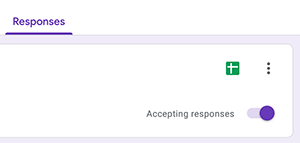To get started, log into your Amherst.edu account and go to the Forms web app. You can also access Google Forms from the Tools & Resources bar on the Amherst site by clicking on the Google Apps / G Suite link.
Creating & Editing Form Fields
When you create a new blank form, you will see the form at the center of the screen with space for a title and description, followed by form fields. Click a form field to edit it and add text. You can use the drop-down menu in the field to choose the field type, such as checkboxes, short answer, or multiple choice.
The floating toolbar on the right of the field lets you add more form fields. On the top-right menu, you can change the form’s design, preview the form, and use the Send button to share the form.
Form Responses
At the top of the form, you will see a Questions tab and a Responses tab. Click the Responses tab to see your form’s current responses. You can also create a new (or select an existing) Google Sheet to store your responses by clicking on the green Sheets icon in the Responses tab or the Select Response Destination in the menu to the right of the icon.
Note: You can store results from multiple forms in one spreadsheet; each form’s responses will be saved to a separate tab.
Word & Character Limits
When creating short answers and paragraph questions, you can add an “expression” that limits a submitter’s response. The two most common expressions are limiting the number of characters in a response and limiting the maximum number of words in a response.
To create an expression, select the three circles in the bottom-right corner of your question box and select “Response Validation.” In the response validation string, select “Regular Expression” and “Contains.”
If you would like to limit the number of characters that a person can submit in their answer, copy and paste the following expression in the “Pattern” section, with X,XXX being however many characters you want to limit:
If you would like to limit the number of words that a person can submit in their answer, copy and paste the following expression in the “Pattern” section, with X,XXX being however many words you want to limit:
Form Notifications
By default, Google Forms can email you whenever a form is filled out. If you’re using a Google Sheet for your responses, go to Tools and then Notification Rules for expanded options. Here you can set the form to email you once a day with a summary of all responses (“Daily Digest”) or set it to alert you whenever changes are made to a form entry.
Sharing Forms
When you’re ready to share your form, click the Send button in the top right to share the form via email or copy a link to the form. You can email the form directly to people via the Email button or send them a link via the Link button. To have the form collect Amherst College emails, check the “Automatically collect respondent's Amherst College email address” box. If you do this, a login will be required to fill out the form.
If you know that everyone filling out the form is in the Amherst community (i.e., they will be viewing the email using their Amherst Gmail account), you can include your form directly in the email body; the submitter can fill out and submit the form directly from within their inbox.




